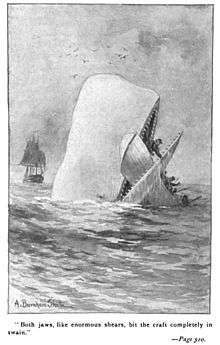Devil Whale
The Devil Whale is a legendary demonic whale-like sea monster (or a sea turtle in some legends). According to myths, this whale is of enormous size and could swallow entire ships. It also resembles as an island when it's sleeping, and unsuspecting sailors put ashore on its back.[1][2] When the sailors start a fire, the Devil Whale awakes and attacks the ship, dragging it to the bottom of the sea. Because of this Christianity began associating the whale with the Devil.[3] This story is found in Sinbad the Sailor.[4]
 | |
| Country | Ireland |
|---|---|
| Region | Atlantic Ocean |
History
The incident of the whale island on Sindbad's First Voyage, from Baghdad and Basra, may be compared with whales described by "Pliny (23 AD–79 AD) and Solinus, covering four jugera, and the pristis sea-monster of the same authorities, 200 cubits long; Al Kazwini tells a similar tale of a colossal tortoise. Such Eastern stories are probably the original of the whale-island in the Irish travel-romance of St Brandan".[5] Early explorer Saint Brendan the Navigator (c. AD 484 – c. 577), in his travels, reportedly landed on the back of a gigantic whale on Easter Sunday, mistaking it for an island. Soon as his monks started a fire to cook their meal, the "island" began to swim away and the sailors quickly scrambled back to their boats.
Guillaume le Clerc [13th century AD] has this to say:
- But there is one monster, very treacherous and dangerous. In Latin its name is Cetus. It is a bad neighbor for sailors. The upper part of its back looks like sand, and when it rises from the sea, the mariners think it is an island. Deceived by its size they sail toward it for refuge, when the storm comes upon them. They cast anchor, disembark upon the back of the whale, cook their food, build a fire, and in order to fasten their boat they drive great stakes into what seems to them to be sand. When the monster feels the heat of the fire which burns upon its back, it plunges down into the depths of the sea, and drags the ship and all the people after it.(Bestiaire)
In Herman Melville' novel Moby Dick (1851) about the hunting of a whale there is allusions to both character the Devil Whale.[6] and to the biblical Leviathan.[7]
The Devil Whale name was used to describe the California gray whale by Japanese whalers. In 1908, a Japanese whaler related stories about hunting gray whales, which he referred to as "Kukekua Kugira" (Devil Whale) due to the difficulty and danger in hunting it.[8]
References
- Waugh, Arthur. “The Folklore of the Whale.” Folklore, vol. 72, no. 2, 1961, p. 363. Accessed 13 Mar. 2020].
- Hamilton, Sue L. (2010). Creatures of Abyss. ABDO. pp. 6–7. ISBN 1604532610.
- Waugh, Arthur. “The Folklore of the Whale”, p.363.
- Sinbad the Sailor#First Voyage of Sinbad the Sailor
- "Voyages of Sinbad the Sailor", 1911_Encyclopædia_Britannica
- Stanonik, Janez (1962). Moby Dick: the myth and the symbol: A study in folklore and literature. Ljubljana University Press. p. 62.
- Newton Arvin, Herman Melville (New York: William Sloane Associates, Inc., 1950.
- Young, Henry Walter (May 1913). "Rediscovering the Gray Whale". Popular Electricity and the World's Advance. Chicago, IL: Popular Electricity Publishing Co. 6 (1–6): 538–539.